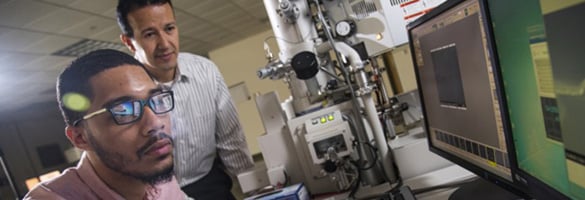Master of Science in Electronics Engineering with a track in Microelectronics and Photonics Online
Fuel your career growth in one of the most high-demand and high-paying technology industries. Supercharge your career and develop next-gen skills to move into the forefront of the engineering field.
Home Degrees Technology Electronics Engineering Master of Science in Electronics Engineering with a track in Microelectronics and Photonics
Program Overview
Set yourself apart with a master’s electronics engineering – photonics & microelectronics degree

Be prepared to match technological changes with your innovation. The online Master of Science in Electronics Engineering with a track in Microelectronics and Photonics from Norfolk State readies you with sought-after technical skills and training to support your professional growth in the field of electronics engineering.
Designed for astute engineers, this specialized and highly technical program equips you with robust understandings of semiconductors to activate the performance, speed, and functionality of cutting edge, high-tech devices. This program also prepares you to apply the effects of quantum mechanics to power lasers, detectors, sensors and optical systems—critical work that has a high need for qualified engineering professionals. You will culminate your learning experience with an advanced project and graduate ready for leading positions or extended Ph.D. work.
Graduates of the microelectronics & photonics engineering master’s degree program will:
- Apply principles of electromagnetism antennas, waveguide discontinuities and equivalent impedance calculations
- Examine the methods that are used to predict the deflections of common mechanical structures used in MEMS
- Understand the fundamentals of semiconductor processing technology, including semiconductor substrates, microfabrication techniques and process integration
- Utilize waveguide theory, signal impairments, laser modulation and photo detection for communication systems
- Apply principles of electromagnetism antennas, waveguide discontinuities and equivalent impedance calculations
- Examine the methods that are used to predict the deflections of common mechanical structures used in MEMS
- Understand the fundamentals of semiconductor processing technology, including semiconductor substrates, microfabrication techniques and process integration
- Utilize waveguide theory, signal impairments, laser modulation and photo detection for communication systems
Career opportunities:
- ASIC/VLSI Design Engineer
- Design Integration Engineer
- Digital Design Engineer
- Microelectronics Circuit Design Engineer
- RTL Design Engineer
- ASIC/VLSI Design Engineer
- Design Integration Engineer
- Digital Design Engineer
- Microelectronics Circuit Design Engineer
- RTL Design Engineer
Also available:
NSU offers the online M.S. Electronics Engineering in a variety of tracks. View all options.
Ranked #8
among “HBCU Schools Offering Engineering Programs” by HBCU Colleges (2018)
Need More Information?
Call 877-660-0459
Call 877-660-0459
Tuition
Invest in your career success
Our student-centered focus is reflected in our affordable tuition for the online M.S. Electronics Engineering – Microelectronics & Photonics. Gain a top-tier Norfolk State University education and benefit from the flexibility of paying by the course.
Tuition breakdown:
| Program | Per Credit Hour | Per Course | Per Program |
|---|---|---|---|
| M.S. Electronics Engineering – Microelectronics & Photonics | $450 | $1,350 | $13,500 |
*Tuition and fees are subject to change at any time.
Tuition breakdown:
Calendar
Choose the start date that is convenient for you
With 7-week courses and multiple start dates a year, the online programs at NSU are designed to be ideal for working professionals.
Now enrolling:
| Term | Start Date | App Deadline | Document Deadline | Registration Deadline | Tuition Deadline | Class End Date |
|---|---|---|---|---|---|---|
| Spring 1 | 1/21/25 | 1/10/25 | 1/15/25 | 1/21/25 | 1/21/25 | 3/7/25 |
| Summer 1 | 5/12/25 | 4/28/25 | 4/28/25 | 5/10/25 | 5/10/25 | 6/27/25 |
Now enrolling:
Have questions or need more information about our online programs?
Ready to take the rewarding path toward earning your degree online?
Admissions
Be prepared to meet the master’s microelectronics & photonics engineering admission criteria
The online M.S. Electronics Engineering – Microelectronics & Photonics program features a streamlined admission process to help you get started quickly and easily. View the full requirements for admission below.
- Bachelor’s degree in a related field
- 2.8 GPA or higher
- 3 Letters of recommendation
Applicants to the NSU Online M.S. Electronics Engineering – Microelectronics & Photonics must meet the following criteria for admission.
- 2.8 GPA or higher
- Specific undergraduate degree relevancy is required. Strong mathematics background is preferred. Bachelor’s degrees may include:
- Electrical or electronics engineering
- Physics
- Mathematics
- Computer engineering
- Electronics engineering technology
- Three letters of professional recommendations, including one from a former professor (if possible). Letters from personal contacts will not be accepted.
- One statement of purpose
- Resume or CV
- Professional work experience is not required
Courses
Discover new insights in the master’s microelectronics & photonics engineering courses
For the online M.S. Electronics Engineering – Microelectronics & Photonics program, you must complete 10 courses totaling 30 credit hours, including 15 credit hours of core courses and 15 credit hours of electives.
Ranked #23
Among the “Top Performers on Social Mobility, Regional Universities South” by U.S. News & World Report Best Colleges Rankings (2021)
Request more information
Submit this form, and an Enrollment Specialist will contact you to answer your questions.
Or call 877-660-0459
By submitting this form, I am providing my digital signature agreeing that Norfolk State University (NSU) and its agent, Risepoint, may email me or contact me regarding educational services by telephone and/or text message utilizing automated technology or a pre-recorded message at the telephone number(s) provided above. I understand this consent is not a condition to attend NSU or to purchase any other goods or services. Privacy Policy. SMS Terms
Begin Application Process
Start your application today!
for help with any questions you may have.